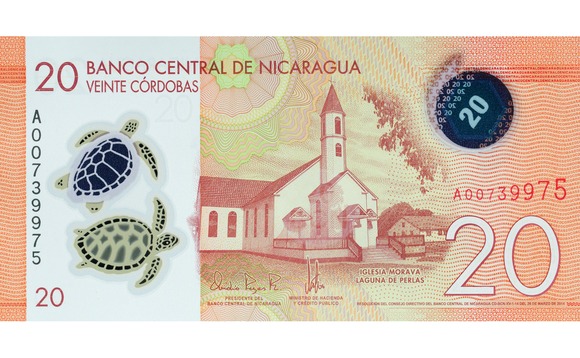
Consultancy and advisory services provider of the year (bespoke): Innovia Security
Polymer specialist offers advisory services from design through to recycling

Cash remains an integral part of the global payments landscape. And as with any method of payment, there is a security risk, most notably linked to the counterfeiting of banknotes. To combat this threat, the industry has striven to create state-of-the-art security features, often impenetrable to the outside world. The creation of polymer banknotes, which can offer greater durability as well as new mechanisms to defeat counterfeiters, has been one such initiative.
For central banks, making a switch from cotton to polymer notes comes with a host of challenges – design and production being just two of them. For smaller central banks, finding adequate resources to tackle these issues is not always a trivial exercise. Having a trusted consultant on hand to offer advice can make the transition much simpler.
The Central Bank of Nicaragua launched its first polymer banknotes in 2009, becoming the first Central American nation to put 'plastic money' into circulation. The central bank received assistance from Innovia's Australia-based PolyTeQ Services – the technical service division of Innovia Security, producer of the Guardian substrate that has been used in 80 denominations in more than 20 countries.
Through technical seminars, which cover the entire cash cycle, the central bank was able to utilise Innovia's expertise in a range of areas, including counterfeit analysis, design, recollection and disposal. "We ran a number of tailored seminars with the central bank to ensure the transition from paper to polymer was as smooth as possible," says Bernhard Imbach, managing director at Innovia Security. "We do not like to leave our clients alone, and so we had a range of courses ready on hand for them."
Amid much public interest, 10, 20 and 200 cordoba notes were printed on polymer in 2009 because of the increased security and durability compared with paper predecessors – reportedly increasing the estimated life cycle of the notes from 12 months to 24 months. However, despite a largely positive reception, the central bank identified a number of areas that required further improvement, including issues related to distinguishing between the denominations and problems with equipment not processing the notes correctly.
An eye for design
The Central Bank of Nicaragua once again selected Innovia for its 2015 series, also employing its consulting services to ensure the issues raised during the previous project were addressed. "The launch of the second series represented the next phase in this project," says Imbach. "We assisted with launch programme advisory services, including an expanded risk management workshop to build on the experiences of the first launch and to identify any further elements of risk which needed to be addressed."
Innovia offered important counsel to the central bank regarding the design of the new series, with the central bank providing the imagery and themes to be included in each denomination, while Innovia worked on the final designs, specifications and tolerances. "This exercise included multiple sessions with the central bank to review proposed designs until we had met their expectations," says Imbach.
Innovia's contributions have been fundamental for the [new banknote series] project’s development. The range of issues on which the company provides advice, and their disposition to contribute to our central bank success
Guillermo Selva, Central Bank of Nicaragua
A polymer banknote opens new security opportunities for central banks because of the 'window element' that is integrated into every note. Unlike 'paper' bank notes, 'plastic' bank notes require specific features to be placed in specific locations on the note to make them machine readable.
"We advised Nicaragua throughout the design process on where to place security features. For example, they can't be placed anywhere where the note would normally be folded," Imbach explains. During the consultation process, the Nicaraguan central bank had the opportunity to submit multiple designs to Innovia for critique.
There is a noticeable difference between the notes issues in 2009 and those issued from October 2015 onwards, with far stronger contrasting colours being used for the latter. "While the predominant colours of the new notes are similar to their 2009 versions, the colours used are much stronger and more saturated, providing a more marked difference," says Guillermo Selva, currency executive at the Central Bank of Nicaragua.
Collaborative effort
Advisory support was also provided in terms of production. The Central Bank of Nicaragua had chosen France-based Oberthur to print its banknotes, meaning a period of collaboration was needed to ensure all the elements of the series were printed successfully. "For central banks that do not have a national printworks, we work with their chosen supplier to make sure they are able to process the polymer as well as they would have with the former substrate," says Innovia's Imbach.
Innovia also assists and advises local printworks on how to process the polymer. As a result, the company worked closely with both the Nicaraguan central bank's cash processing staff and the processing machine suppliers to ensure a seamless transition and the adoption of best-practice polymer processing procedures.
 "Innovia's contributions have been fundamental for the project's development," says Selva. "The range of issues on which the company provides advice, and their disposition to contribute to our central bank success."
"Innovia's contributions have been fundamental for the project's development," says Selva. "The range of issues on which the company provides advice, and their disposition to contribute to our central bank success."
But it was the collaboration with local recyclers that arguably has reaped the most benefit. "The central bank had always intended to work with a recycling programme to reduce our impact on the environment," says Selva. When using paper notes, the central bank was not able to reuse the bank notes, and incinerated worn-out currency. By contrast, at the end of their life, the new polymer notes are taken to Producol, a local recycler.
"Following work undertaken by Innovia, we were able to find a viable option for recycling the banknotes as part of the Guardian Global Recycling Program," says Selva. Currently, the central bank has recycled more than 80 tonnes of polymer waste.
Marketing magic
Innovia's consultancy services span all the way from the benefits of polymer adoption to note recycling. But a number of central banks also take advantage of Innovia's marketing services to ensure members of the public remain confident in their currency once a shift is made to polymer notes.
This is not limited to Nicaragua. When the Central Bank of Mauritania launched a new polymer banknote denomination (the 1,000 ouguiya in 2014), not only did it make the decision to switch from paper to polymer, but it also decided to educate the younger generation by creating a bilingual children's booklet (in French and Arabic), providing information on the new notes, from identification to security features, which was supplied to schools across the country.
"We did a lot of marketing work in collaboration with the central bank to support the bank's efforts in ensuring the notes would be accepted by the public," says Imbach. "We are now in a new era of banknote production, and it is imperative the public trusts the currency. Without confidence, the notes will not be a success."
Images: Stuart Walker Photography; Peter Kotsa Photography
Only users who have a paid subscription or are part of a corporate subscription are able to print or copy content.
To access these options, along with all other subscription benefits, please contact info@centralbanking.com or view our subscription options here: subscriptions.centralbanking.com/subscribe
You are currently unable to print this content. Please contact info@centralbanking.com to find out more.
You are currently unable to copy this content. Please contact info@centralbanking.com to find out more.
Copyright Infopro Digital Limited. All rights reserved.
As outlined in our terms and conditions, https://www.infopro-digital.com/terms-and-conditions/subscriptions/ (point 2.4), printing is limited to a single copy.
If you would like to purchase additional rights please email info@centralbanking.com test test test
Copyright Infopro Digital Limited. All rights reserved.
You may share this content using our article tools. As outlined in our terms and conditions, https://www.infopro-digital.com/terms-and-conditions/subscriptions/ (clause 2.4), an Authorised User may only make one copy of the materials for their own personal use. You must also comply with the restrictions in clause 2.5.
If you would like to purchase additional rights please email info@centralbanking.com test test test





